|
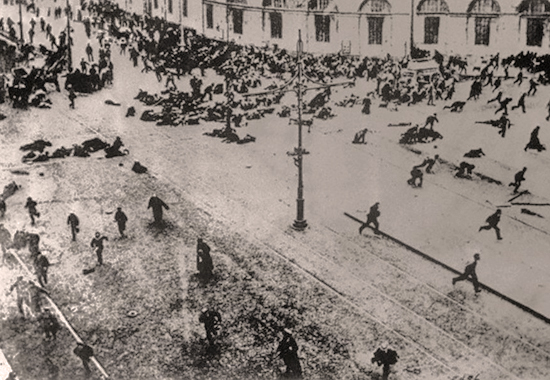
THE RUSSIAN REVOLUTION
1917
Fighting for a
Classless Society
The Russian
Revolution of 1917 is also called the
Second Russian
Revolution, the
First Russian Revolution being the
 Russian Revolution of 1905.
Russian Revolution of 1905.
|
|
The Russian Revolution in a Nutshell
The Russian
Revolution of 1917 ended the country’s monarchy.
This monarchy had ruled Russia since 1547, when
 Ivan the Terrible
was officially crowned Czar of all Russia.
Ivan the Terrible
was officially crowned Czar of all Russia.
From 1613 until 1917, the ruling scepter was in
the hands of the
 Romanovs. Romanovs.
By the way, is it
 Czar,
Tsar, or Tzar? Czar,
Tsar, or Tzar?
The revolution
of 1917 also marked the beginning of a new governmental
system founded on
 Communism. Within the borders
of the Union of Soviet Socialist Republics
(USSR) at its greatest extent,
over one-sixth of the Earth was ruled by this
new type of government. Communism. Within the borders
of the Union of Soviet Socialist Republics
(USSR) at its greatest extent,
over one-sixth of the Earth was ruled by this
new type of government.
Top Picture
The photograph at the top of the page shows the
streets of
 Petrograd (now Saint Petersburg) on July 4, 1917.
We witness a street demonstration at the Nevsky Prospekt /
Sadovay Street intersection just after troops of the
Petrograd (now Saint Petersburg) on July 4, 1917.
We witness a street demonstration at the Nevsky Prospekt /
Sadovay Street intersection just after troops of the
 Provisional Government have opened fire with
machine guns. Provisional Government have opened fire with
machine guns.
It follows a brief
summary of the Russian Revolution:
|
The Russian Revolution of 1917 —
Events Unfold
Riots and strikes erupted in March
1917. Soldiers ceased to obey Czar
 Nicholas II.
The Czar was forced to abdicate on March 15, 1917, and the Nicholas II.
The Czar was forced to abdicate on March 15, 1917, and the
 Provisional Government came to
power, led by
Prince Georgy Lvov and later by Provisional Government came to
power, led by
Prince Georgy Lvov and later by
 Aleksandr F. Kerensky
as Prime Minister.
Aleksandr F. Kerensky
as Prime Minister.
The new government, however, failed to take decisive action on two
main issues: the distribution of land and the country’s
participation in
 World War I.
At the same time, the general population became increasingly radical
in their demands.
World War I.
At the same time, the general population became increasingly radical
in their demands.
Furthermore, the Provisional Government had
trouble within their ranks. On September 1, 1917, commander-in-chief
 Lavr G. Kornilov was arrested
for plotting against the Provisional Government and attempting to establish a
military regime in its place.
Lavr G. Kornilov was arrested
for plotting against the Provisional Government and attempting to establish a
military regime in its place.
The
 Bolsheviks competed with the
Provisional Government for power. By September their program of Peace,
Land, and Bread had made them popular. The Bolsheviks
recognized the time was right to take power. Bolsheviks competed with the
Provisional Government for power. By September their program of Peace,
Land, and Bread had made them popular. The Bolsheviks
recognized the time was right to take power.
Without any noteworthy resistance, the Bolsheviks captured the
government buildings and other strategically important points in
 Petrograd (St. Petersburg). Moscow and most other cities were taken
soon afterward. Members of the Provisional Government were either
arrested or fled the country.
Petrograd (St. Petersburg). Moscow and most other cities were taken
soon afterward. Members of the Provisional Government were either
arrested or fled the country.
A new government, the
Council of People’s
Commissars, was set up with
 Vladimir
I. Lenin as Chairman, Vladimir
I. Lenin as Chairman,
 Leon Trotsky as foreign
commissar,
Leon Trotsky as foreign
commissar,
 Aleksey Ivanovich Rykov
as interior commissar, and Aleksey Ivanovich Rykov
as interior commissar, and
 Joseph Stalin as commissar of
nationalities.
Joseph Stalin as commissar of
nationalities.
And here is the
 Timeline of the Russian Revolution
Timeline of the Russian Revolution
The Russian Revolution
- When Did It Start? When Did It End?
The Russian Revolution of 1917
comprises two revolutions.
February Revolution - March 8–12
(February 23–27,
 old style)
old style)
The revolution started when unrest emerged because of food shortages
and Russian's poor performance in
 World War I.
World War I.
The first stage of the revolution of
1917 overthrew the monarchy and replaced it by the
 Provisional
Government, which was to remain in office until a democratic
parliament was arranged.
Provisional
Government, which was to remain in office until a democratic
parliament was arranged.
 Check this event in the WWI timeline.
Check this event in the WWI timeline.
 Check this event in the Russian Revolution
timeline.
Check this event in the Russian Revolution
timeline.
October Revolution - November 6–7 (October 24–25,
 old style)
old style)
Led by the Military
Revolutionary Committee, the
Bolsheviks took over administrative buildings of
the Provisional Government, and the
Winter Palace
in
 Petrograd (St. Petersburg,) which had been
the primary residence of the Russian tsars since 1761.
Petrograd (St. Petersburg,) which had been
the primary residence of the Russian tsars since 1761.
Also
called the Bolshevik Revolution, the second stage of the revolution
of 1917 brought the
Bolshevik Party to power and established the
 Soviet Communist
government in Russia.
Soviet Communist
government in Russia.
 Check this event in the WWI timeline.
Check this event in the WWI timeline.
 Check this event in the Russian Revolution
timeline.
Check this event in the Russian Revolution
timeline.
When Did
the Russian Revolution End? - Controversy
Strictly speaking, the duration of a
revolution is timed from the complete overthrow of the established
government by those who were previously subject to it, to the
successful formation of a new form of government and a general
return to a structured life.
For historians this last part, the
general return to a structured life after the Bolshevik Revolution, is a head scratcher. Therefore, it is a matter of debate
when exactly the Russian Revolution ended.
Some treat the subsequent
 Civil War 1918-1920, the time of the
Civil War 1918-1920, the time of the
 New Economic Policy (NEP)
1921-1928, and Stalin's first Five-Year Plan 1928-1932 as part of
the Russian Revolution.
New Economic Policy (NEP)
1921-1928, and Stalin's first Five-Year Plan 1928-1932 as part of
the Russian Revolution.
If you prefer the big picture you
probably favor this view, and the skeleton of your Russian Revolution study notes might look
like this.
Old Style - New Style
Dates
Russia didn’t make the change
from the
 Julian calendar to the
Julian calendar to the
 Gregorian calendar until 1918.
Therefore, the October Revolution actually took place in November.
Gregorian calendar until 1918.
Therefore, the October Revolution actually took place in November.
In the Russian
calendar January 31, 1918 was followed by February 14, 1918.
By the way, if you get excited about calendars
have a look at Claus Tøndering's
 Frequently
Asked Questions about Calendars. Frequently
Asked Questions about Calendars.
The Battles of the
Russian Revolution of 1917
How many battles were fought in
the Russian Revolution of 1917? None. The Russian Revolution of 1917 saw many armed encounters,
uprisings, and riots, but no official battles.
The
 Russian Civil War, on the other
hand, saw quite a few.
Russian Civil War, on the other
hand, saw quite a few.
Check the
 Battles of the Russian Civil War.
Battles of the Russian Civil War.
What were the background issues of the
Russian Revolution of 1917?
Causes of the Russian
Revolution of 1917
Much simplified, people were frustrated with
Russia's social, economic, and political situation. More
importantly, people were distressed by the fact that there was no
competent leader who could get them out of this mess.
-
The
 Revolution
of 1905 did not bring any lasting changes, but
it sure whetted the citizens' appetite for civil rights. Revolution
of 1905 did not bring any lasting changes, but
it sure whetted the citizens' appetite for civil rights.
-
 World War I fueled public discontent when the Russian army, led by
an incompetent Czar, lost battle after battle.
World War I fueled public discontent when the Russian army, led by
an incompetent Czar, lost battle after battle.
-
Meanwhile at home,
Tsarina Alexandra,
who grew up as a German princess, added
insult to injury. In Nicholas' absence, she fired qualified
personnel, replaced it by knuckleheads, and declared controversial
character
 Rasputin
a saint. Rasputin
a saint.
Consequently, her subjects spread the word that
she was a German spy and a nymphomaniac in
liaison with Rasputin, who had his own
sinister agenda and who had made Nicholas
his puppet on a string.
-
In addition,
food shortages became even more severe and
the inflation rate went up.
-
The tsar seemed unable to improve
conditions and was stubbornly unwilling to explore other options.
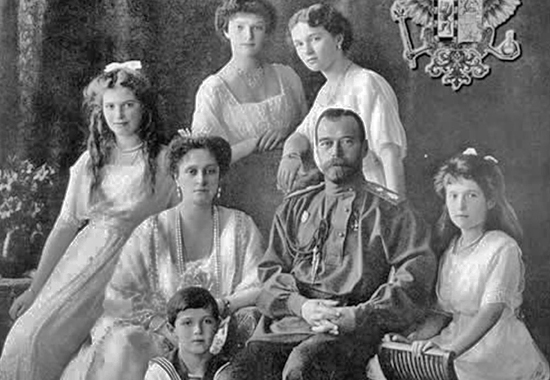
EMPEROR NICHOLAS II AND HIS FAMILY 1914 -
EMPRESS ALEXANDRA FYODOROVNA AND THEIR CHILDREN (LEFT TO RIGHT)
MARIA, ALEXIS, TATIANA, OLGA, ANASTASIA
Society
of Orthodoxy, St Petersburg
What Is the Number of
Casualties of the Russian Revolution of 1917?
William Edward Eckhardt gave an
estimate of 1,000 civilian and 1,000 military deaths, making it 2,000
deaths total for the Russian Revolution of 1917.
( Source) Source)
Who Fought the Russian
Revolution of 1917?
A short Who's Who of the
Russian Revolution. Here are the main forces,
fractions, groups, organizations, and participants of the
Russian Revolution 1917.
 Go here for the military leaders from March
until November 1917.
Go here for the military leaders from March
until November 1917.
Military Forces -
The Imperial Army
Emperor
 Nicholas II lost his
imperial army and navy when things went down the drain in early 1917
and his soldiers
joined the revolutionaries. Nicholas abdicated on March 15, 1917.
Nicholas II lost his
imperial army and navy when things went down the drain in early 1917
and his soldiers
joined the revolutionaries. Nicholas abdicated on March 15, 1917.
 Check this event in
the Russian Revolution Timeline
Check this event in
the Russian Revolution Timeline
Individual soldiers of the Imperial Army
later fought against each other. How so? During the
subsequent
 Russian Civil War
1917 until 1920, some ex-imperials sided with the Bolsheviks
and fought in
the
Russian Civil War
1917 until 1920, some ex-imperials sided with the Bolsheviks
and fought in
the
 Red Army
against those who sided against the Bolsheviks and fought in the Red Army
against those who sided against the Bolsheviks and fought in the
 White Army.
White Army.
Military Forces - The Red Guards
The Red Guards
were armed workers and the
 Bolshevik's
private militia. These guys became the core
of the Red Army.
Bolshevik's
private militia. These guys became the core
of the Red Army.
The Provisional Government
Who gave birth
to the Provisional Government?
The Duma ( What is the Duma?)
shaped the Provisional Government and set it
in motion. The
Provisional Government
accepted Nicholas' abdication and took it from there.
What is the Duma?)
shaped the Provisional Government and set it
in motion. The
Provisional Government
accepted Nicholas' abdication and took it from there.
The
Provisional Government was in effect from
March 1917 until October 1917. During this
short time period the Provisional Government
was several times reorganized and
restructured.
The first prime minister
of the Provisional Government was
 Georgy
Yevgenyevich Lvov. Georgy was a prince and had previously done a lot
of good for his country.
Georgy
Yevgenyevich Lvov. Georgy was a prince and had previously done a lot
of good for his country.
Initially, all
members of the Provisional Government were liberal ministers, except
 Alexander Kerensky, who was a
revolutionary. Kerensky became Minister of Justice and later Prime Minister
himself.
Alexander Kerensky, who was a
revolutionary. Kerensky became Minister of Justice and later Prime Minister
himself.
The Provisional Government wanted to
keep Russia in World War One.
The
Petrograd Soviet of Workers' and Soldiers' Deputies
This
Soviet ( What is a Soviet?)
had 2,500 deputies. One deputy represented
1,000 workers.
What is a Soviet?)
had 2,500 deputies. One deputy represented
1,000 workers.
Most deputies were members of
the  Socialist Revolutionary Party and Socialist Revolutionary Party and  Mensheviks.
Some were
Mensheviks.
Some were  Bolsheviks but
they were the
minority. Bolsheviks but
they were the
minority.
The Petrograd
Soviet of Workers' and Soldiers' Deputies
was established on March 12, 1917. This Soviet
replaced an older soviet that had been founded in
 Petrograd
(then Saint Petersburg) during the
Petrograd
(then Saint Petersburg) during the
 Revolution of 1905. Revolution of 1905.
 Check this event in the Russian Revolution Timeline.
Check this event in the Russian Revolution Timeline.
The Petrograd
Soviet wanted to
Russia out of
 World War One. Seeing that their demands
stood in exact opposition to the
World War One. Seeing that their demands
stood in exact opposition to the
 Provisional Government, the Soviet ordered the military to disobey the Provisional
Government. Provisional Government, the Soviet ordered the military to disobey the Provisional
Government.
 Check this event in the Russian Revolution Timeline.
Check this event in the Russian Revolution Timeline.
In the summer of 1917, Soviets from all
across the country united as the
All-Russian Soviet
of Workers' and Soldiers' Deputies.
This Soviet made it their job to monitor the
Provisional Government and to keep it in
line, which, in effect, made it a second
government.
This strenuous
coexistence is called the
dual power.
Political Parties -
The Socialist Revolutionary Party
The SR
was founded in 1901. The party closed their
doors for good when the
 Bolsheviks unleashed
their Red Terror
in September 1918.
Bolsheviks unleashed
their Red Terror
in September 1918.
See also
 The SRP in the Russian
Civil War.
The SRP in the Russian
Civil War.
Political Parties - The Bolsheviks
Before the
Bolsheviks became Bolsheviks, they were just
wing members of the
Russian
Social-Democratic Workers' Party,
also called the Russian Social-Democratic
Labor Party.
This party was founded in 1898 in Minsk. And
here is Minsk, the capital of Belarus, on a
Google map.
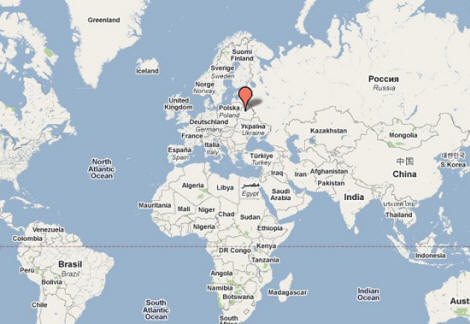
MINSK, BELARUS - MAP LOCATION
Google
Maps
This wing of the RSDWP was headed by
 Vladimir I. Lenin.
Lenin and his comrades demanded that their party
should award membership only to qualified
revolutionaries.
Vladimir I. Lenin.
Lenin and his comrades demanded that their party
should award membership only to qualified
revolutionaries.
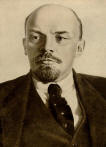
WING LEADER V.I. LENIN
Library
of Congress
Click to enlarge
In 1903, at the
party's Second Congress with sessions in
Brussels and London, this dispute was the
number one topic. Lenin's group gained the
majority of the debate and henceforth they called
themselves the
Bolsheviks. Bolshevik is a Russian
word and means One of the Majority.
You
have one Bolshevik and two Bolsheviks
or Bolsheviki.
The opposite right
wing was headed by L.
Martov, who was really
Yuly Osipovich
Tsederbaum. Other prominent leaders were
Georgy
Valentinovich Plekhanov
and
 Leon Trotsky. And while on the roll with
the name-giving, the Bolsheviks called a member
of the opposite right wing Menshevik,
another Russian word meaning One of the
Minority.
Leon Trotsky. And while on the roll with
the name-giving, the Bolsheviks called a member
of the opposite right wing Menshevik,
another Russian word meaning One of the
Minority.
You have one
Menshevik and two Mensheviks or
Mensheviki.
The Bolsheviks went down in popularity but gained momentum
again, thanks to Lenin who came back into
the country, in October 1917. Eventually, they became
the victors of the Russian October
(November) Revolution in
1917, which is hence also called the
 Bolshevik Revolution. Bolshevik Revolution.
What happened to the Mensheviks after 1917?
It went downhill from there for the
Mensheviks.
And by 1922 the Mensheviks, alongside the
 Socialist
Revolutionary Party, the
Socialist
Revolutionary Party, the
 Kadets,
and others, were completely off
the radar, victims of the Bolshevik
Red Terror. Kadets,
and others, were completely off
the radar, victims of the Bolshevik
Red Terror.
The Red
Terror, by the way, was an official campaign
of the Bolshevik government, starting in
September 1918. The new rulers were proud to
be tough and violent and they broadcasted
their new policy as far as their voices, and
weapons, could carry the message.
The principal
tool applying the Red Terror was the
All-Russian
Extraordinary Commission for Struggle
against Counter-Revolution, Sabotage and
Speculation, aka the
Cheka.
The Cheka had been created in December 1917
and functioned as the secret police.
Thousands were shot without a trial.
What happened to
the Bolshevik party after 1917?
In March 1918,
they became the
Russian Communist Party
and the Bolsheviks ruled Russia. In 1925, their
organization was renamed the
All-Union Communist
Party, and in 1952, it became the
Communist Party of the
Soviet Union, which was dissolved in 1991
only because the Soviet Union ceased to exist.
Back to the
Russian Revolution of 1917.
Political Parties - The Mensheviks
See
above. The Mensheviks were democratic
socialists.
Political Parties - The
Kadets
Kadets, also spelled Cadets, was the name of the members of
the Constitutional Democratic Party, also
called the Party of People's Freedom. This
party was founded in October 1905.
The Kadets
wanted a constitutional monarchy.
What is constitutional monarchy?
According to the experts at Buckingham Palace,
constitutional monarchy means that a monarch
acts as Head of State but the ability to
make and pass legislation resides with an
elected Parliament. Furthermore, the monarch
is bound by the constitution and can't act
according to his or her own free will. On
almost all matters the monarch acts on the
advice of ministers.
Women in the Russian Revolution
Among others, there was
Catherine Breshkovsky
(Catherine Breshkovskaya, Breshka Brashkoski, Yekaterina
Breshko-Breshkovskaya, whatever), who is nicknamed the Little
Grandmother of the Russian Revolution, or бабушка Русской
революции if you speak Russian.
This lady was co-founder and co-leader of
the Russian Socialist Revolutionary Party. Like all decent
Russian revolutionaries, Catherine spent many
years in Siberian exile. After 1917, she left the country and moved
to Prague because she couldn't agree with the Bolsheviks.
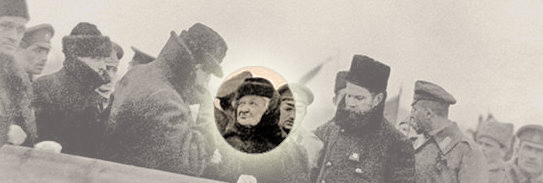
CATHERINE BRESHKOVSKY - MORE BALLS THAN THE REST COMBINED
Source
Unknown
Many other women fought in the Revolution as well, some as
visionary revolutionaries, some as protesters in the streets,
some as armed rebels. Here are more girls with guns.
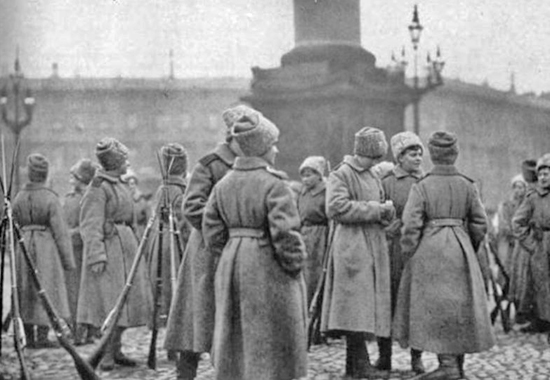
FEMALE UDARNITSKY BATTALION
ASSIGNED TO THE PALACE AREA, 1917
St Petersburg Encyclopaedia
A Udarnik, also called Shock
Worker, was the term for an enthusiastic worker assigned to a
special task of urgency.
Non-Russian States and
the Russian Revolution of 1917
The vast Russian empire of
 Nicholas II included many non-Russian
nations, e.g. the people of Poland, Finland, Estonia, Lithuania,
Latvia, Ukraine, Georgia, Armenia, and Azerbaijan.
Nicholas II included many non-Russian
nations, e.g. the people of Poland, Finland, Estonia, Lithuania,
Latvia, Ukraine, Georgia, Armenia, and Azerbaijan.
When chaos ensued at the Russian
political top, these nations jumped at the
opportunity and fought for their independence, some more
successfully than others. And here is a map of the world in 1910.
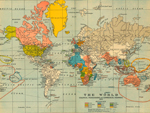
1910 World Map
Click to enlarge
Russian Revolution
and Communist Lingo
What is the
bourgeoisie?
The bourgeoisie is the capitalist middle class.
What is the proletariat?
The proletariat is the lowest class in society, the
workers' class.
What is the
dictatorship of the proletariat?
The dictatorship of the proletariat is
Step 2 in
 Karl Marx' book of the ideal
world. Step one: Capitalism. Step two: The
workers are taking over. Step three: a classless
society.
Karl Marx' book of the ideal
world. Step one: Capitalism. Step two: The
workers are taking over. Step three: a classless
society.
What is a comrade?
Socialists and communists use the word comrade as a replacement for
such titles as Mr. or Mrs.
Should someone address you in such a
fashion, chances are that you are a fellow socialist or communist.
The term comrade has its etymology roots in the Spanish word
camarada, originally chamber-mate. Feel cozy already?
Russian Revolution - Cultural Impact
The unstable conditions in
Russia after 1917 prompted many people, at least
those who could
afford it, to leave their country for good, among
them Sergey
Rachmaninoff and
Marc Chagall.
Or, as in Igor
Stravinsky's case, it destroyed all
hopes of ever coming back home.
What Happened After the Revolution of 1917?
The next chapter in Russian
history, after the Russian
Revolution of 1917, was the
 Russian Civil War,
which was fought from
1917 until 1920.
Russian Civil War,
which was fought from
1917 until 1920.
Russian Revolution Trivia
Here is the link to the Harvard
University
 Russian Research Center
with currently over 700 digitized transcripts of
interviews. Knock yourselves out.
Russian Research Center
with currently over 700 digitized transcripts of
interviews. Knock yourselves out.
More History
|